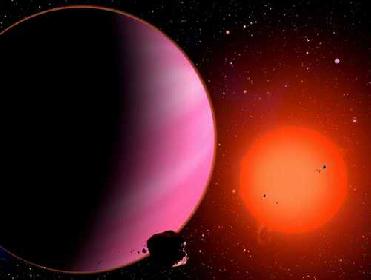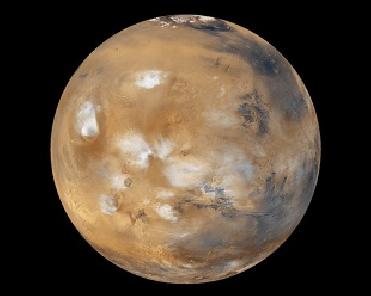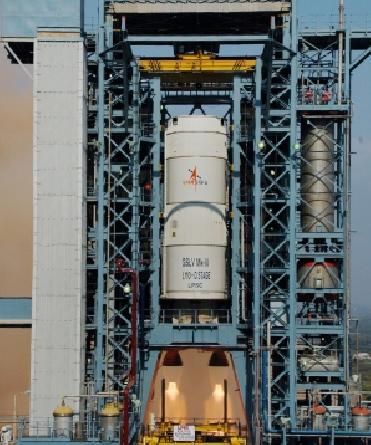
This artist's conception reveals the newly discovered Super-Neptune planet orbiting a star 120 light years away from Earth. Normally blue in color, its red hue is caused by the illumination from the nearby Red Dwarf star. Credit: David A. Aguilar (CfA)
WASHINGTON, DC (BNS): Astronomers from the Harvard-Smithsonian Center for Astrophysics have discovered a new planet named HAT-P-11b, which is 4.7 times the size of Earth and has 25 Earth masses. The planet is somewhat larger and more massive than Neptune, and is orbiting a star 120 light-years from Earth. In comparison, Neptune has a diameter 3.8 times and a mass 17 times that of the Earth.
The astronomers said that HAT-P-11b was discovered while passing directly in front of (transiting) its parent star, thereby blocking about 0.4 percent of the star�s light. This periodic dimming was detected by a network of small, automated telescopes known as �HATNet,� which is operated by the Center in Arizona and Hawaii. HAT-P-11b is the 11th extra-solar planet found by HATNet, and the smallest yet discovered by any of the several transit search projects underway around the world, they said.
�A number of Neptune-like planets have been found recently by radial velocity searches, but HAT-P-11b is only the second Neptune-like planet found to transit its star, thus permitting the precise determination of its mass and radius,� the astronomers said.
The HAT-P-11b orbits very close to its star, revolving once every 4.88 days. As a result, it is baked to a temperature of around 1100 degrees F. The star itself is about three-fourths the size of the Sun and somewhat cooler. The good news is that there are signs of a second planet in the HAT-P-11 system, but more radial velocity data is needed to confirm that and determine its properties.
Another team has located one more transiting super-Neptune, known as GJ436b, around a different star. It was discovered by a radial velocity search and later found to have transits. Harvard astronomer Gaspar Bakos, who led the discovery team, said that having two such objects to compare helps astronomers to test theories of planetary structure and formation.
Scientists say that HAT-P-11 is in the constellation Cygnus, which puts it in the view of NASA�s upcoming Kepler spacecraft. �Kepler will search for extra-solar planets using the same transit technique pioneered by ground-based telescopes. This mission potentially could detect the first Earth-like world orbiting a distant star,� they said.
Robert Noyes, another member of the discovery team said that in addition one expects Kepler to measure the detailed properties of HAT-P-11 with the extraordinary precision possible only from space.
 Previous Article
Previous Article Next Article
Next Article











The Indian Air Force, in its flight trials evaluation report submitted before the Defence Ministry l..
view articleAn insight into the Medium Multi-Role Combat Aircraft competition...
view articleSky enthusiasts can now spot the International Space Station (ISS) commanded by Indian-American astr..
view article